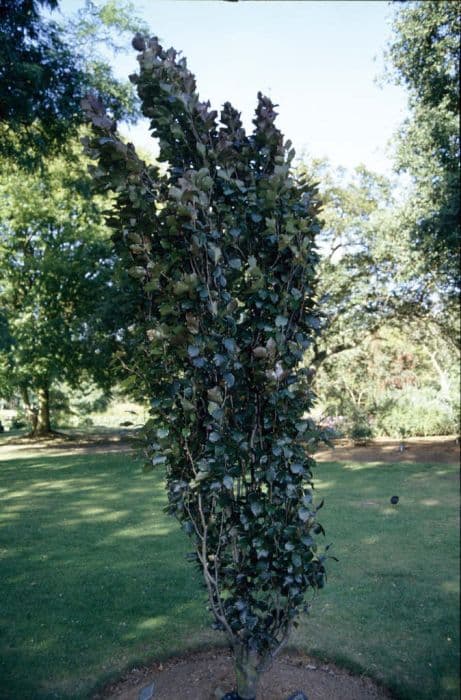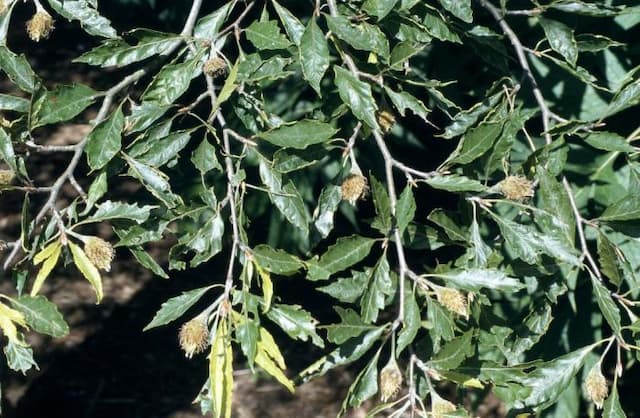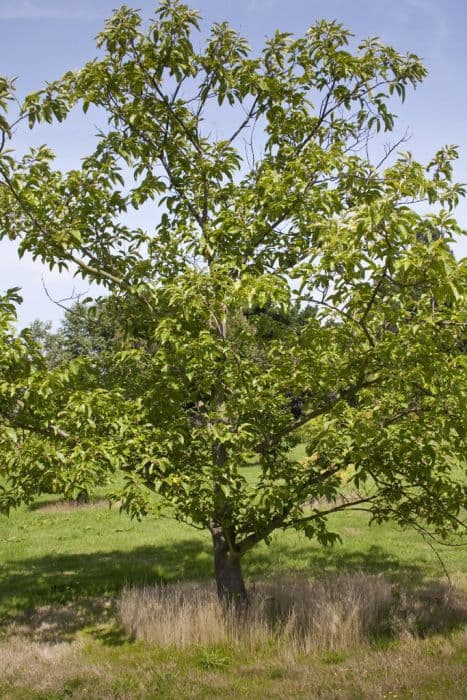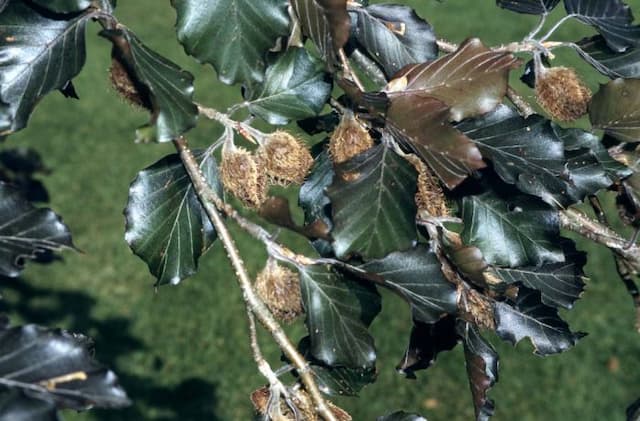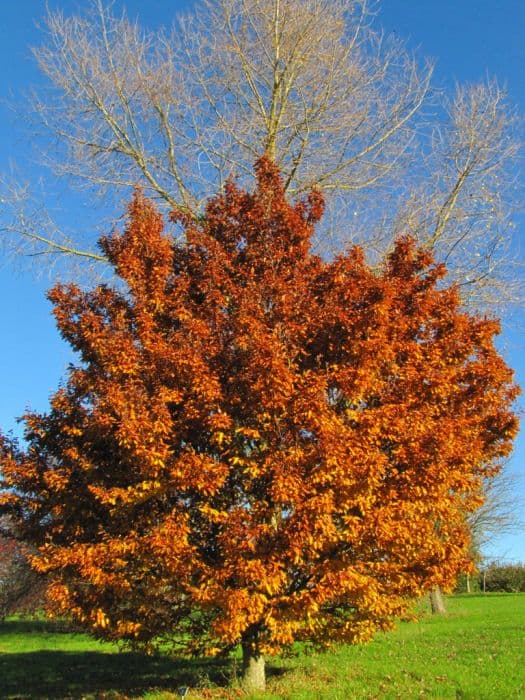Red Oak Quercus rubra

ABOUT
Quercus rubra, commonly known as the northern red oak, is a deciduous tree known for its striking appearance. It bears a broad, rounded canopy with branches that spread to create a lush silhouette. The leaves of the northern red oak are highly distinctive; they are lobed with pointed tips, usually with seven to eleven lobes per leaf, and are a glossy green color that turns to vibrant shades of red, russet, or copper in the autumn. The leaves have a smooth texture above and are often paler with small hairs along the veins beneath. The bark of the northern red oak is another characteristic feature, being dark gray to black with ridges that appear shallow and wide, often resembling ski tracks. As the tree matures, the ridges become deeper and more pronounced. The tree's flowers are relatively inconspicuous, with male flowers in drooping catkins and female flowers as small spikes. The northern red oak produces fruit in the form of acorns that are round to oval in shape, with a scaly, shallow cap covering less than a quarter of the nut. The acorns provide a crucial food source for various wildlife species.
About this plant
 Names
NamesSynonyms
Red Oak, Northern Red Oak, Champion Oak, Eastern Red Oak, Canadian Red Oak.
Common names
Quercus borealis, Quercus maxima (Marshall) Ashe, Quercus maxima (Marshall) Ashe f. maxima, Quercus rubra f. rubra.
 Toxicity
ToxicityTo humans
The most common common name for Quercus rubra is the Northern Red Oak. Generally, this tree is not considered highly toxic to humans. However, consuming large quantities of acorns or leaves, especially when they are young and tender, can potentially cause gastrointestinal distress because they contain tannins. Tannins can be toxic when consumed in large quantities, leading to symptoms such as stomach pain, nausea, vomiting, and diarrhea. Sensitivity varies from person to person, so while some may consume moderate amounts without ill effects, others may be more susceptible to the tannins’ effects.
To pets
For the Northern Red Oak, the toxicity concern for pets, especially dogs and cats, is similar to that in humans. The acorns and leaves contain tannins, which can be harmful to pets if ingested in large amounts. Consuming parts of the Northern Red Oak can lead to gastrointestinal upset in pets, with symptoms such as abdominal pain, vomiting, and diarrhea. In severe cases, there is a risk of kidney damage or liver problems. It's important to discourage pets from eating acorns or leaves from any oak species, including the Northern Red Oak.
 Characteristics
CharacteristicsLife cycle
Perennials
Foliage type
Deciduous
Color of leaves
Green
Height
70 feet 21 meters
Spread
45 feet 13 meters
Plant type
Tree
Hardiness zones
5
Native area
North America
Benefits
 General Benefits
General Benefits- Wildlife Habitat: Quercus rubra, commonly known as the Northern Red Oak, provides a habitat and food source for various wildlife, including birds, squirrels, and insects.
- Shade and Cooling: The tree's large canopy offers ample shade, which helps in cooling the surroundings and reducing energy costs associated with air conditioning.
- Erosion Control: The extensive root system of the Northern Red Oak helps stabilize soil and prevent erosion.
- Esthetic Appeal: With its impressive stature and vibrant fall foliage, the Northern Red Oak is a popular choice for landscaping and adds natural beauty to parks and gardens.
- Timber Production: The wood of the Northern Red Oak is highly valued for its strength and durability, making it a popular choice for furniture, flooring, and construction.
- Carbon Sequestration: Like other trees, the Northern Red Oak plays a role in capturing carbon dioxide from the atmosphere, therefore contributing to climate change mitigation.
- Soil Improvement: The leaf litter from the Northern Red Oak decomposes and enriches the soil with nutrients, promoting the health of surrounding plant life.
 Medical Properties
Medical Properties- Astringent: Quercus rubra bark has traditionally been used for its astringent properties, helping to tighten and tone tissues.
- Anti-inflammatory: It has been noted for its potential to reduce inflammation in traditional medicine uses.
- Antiseptic: The bark possesses antiseptic qualities which may be useful in preventing the growth of microorganisms.
- Diarrhea Treatment: The astringent effect of the tannins contained in the bark is sometimes used in the treatment of diarrhea and dysentery.
- Hemorrhoid Relief: Its astringent properties may provide relief from hemorrhoids when used as a topical application.
- Sore Throat Remedy: Due to its astringent properties, a gargle made from the bark has been used to soothe sore throats.
- Varicose Veins: The bark's ability to constrict may have been used historically in an attempt to treat varicose veins.
- Wound Healing: Compounds in the bark might have been applied to wounds to aid in the healing process.
 Air-purifying Qualities
Air-purifying QualitiesThis plant is not specifically known for air purifying qualities.
 Other Uses
Other Uses- Woodworking: Red oak's hard and attractive wood is highly valued for furniture, flooring, and cabinetry, offering a rich, warm aesthetic.
- Dye Production: The bark of the red oak can be used to produce a natural dye, which varies in color depending on the mordant used.
- Tanning Leather: The high tannin content in red oak bark makes it suitable for the tanning of leather, a practice that dates back centuries.
- Ink Making: Historically, tannin-rich oak galls (abnormal growths) from the red oak were used as a main ingredient in the production of iron gall ink.
- Barrel Making: Red oak wood is sometimes used in making wine barrels, although it’s less common than white oak due to its higher porosity.
- Landscaping: Red oak is used ornamentally for its majestic appearance and vibrant fall foliage, adding visual interest to parks and large gardens.
- Wildlife Habitat: The thick foliage and spreading branches of red oak trees provide ideal habitat and shelter for various wildlife species.
- Erosion Control: With its extensive root system, red oak can be planted on slopes and banks to help stabilize soil and prevent erosion.
- Acorn Flour: Red oak acorns can be leached of their tannins and ground into flour for use in some traditional culinary applications.
- Beekeeping: Red oak produces catkins that yield pollen, which is a valuable foraging material for honey bees in early spring.
Interesting Facts
 Feng Shui
Feng ShuiThe Red Oak is not used in Feng Shui practice.
 Zodiac Sign Compitability
Zodiac Sign CompitabilityThe Red Oak is not used in astrology practice.
 Plant Symbolism
Plant Symbolism- Strength: The Quercus rubra, or Northern Red Oak, symbolizes strength and resilience, reflecting the tree's hardy nature and ability to withstand strong winds and storms.
- Endurance: This tree symbolizes endurance due to its long lifespan and ability to survive in a variety of environments, mirroring the human quality of enduring life's challenges over time.
- Wisdom: Like many oaks, the Northern Red Oak is often associated with wisdom, a nod to its ancient presence and the traditional use of oaks as gathering places for council meetings.
- Nobility: Oaks, in general, carry the symbolic meaning of nobility, with the Northern Red Oak being no exception, showcasing the grandeur and regality of its towering presence.
- Heritage and Family: The Northern Red Oak is symbolic of heritage and the continuity of family, as these trees are long-lived and can be landmarks or touchstones for multiple generations in the same community.
 Water
WaterThe Northern Red Oak should be watered deeply and infrequently, allowing the soil to dry out slightly between watering sessions. For young trees, watering once a week with approximately 15 to 20 gallons of water is ideal, depending on the weather conditions. Mature Northern Red Oaks may only need watering during prolonged dry spells. It is crucial to avoid overwatering as this can lead to root rot. Seasonal adjustments should be made, with more frequent watering in dry, hot summer months and reduced watering in the cooler, potentially wetter fall.
 Light
LightNorthern Red Oak thrives in full sun to partial shade. It should be planted in a spot where it can receive at least six hours of direct, unfiltered sunlight per day. The best spot for the Northern Red Oak is an open area away from buildings or other trees that could cast too much shade on it.
 Temperature
TemperatureThe ideal temperature range for the Northern Red Oak is between 60 and 80 degrees Fahrenheit. This tree can withstand minimum winter temperatures down to -30 degrees Fahrenheit. Northern Red Oaks are adaptable to a wide range of temperature fluctuations, but optimal growth occurs within the stated ideal range.
 Pruning
PruningPruning the Northern Red Oak is important for removing any dead or diseased branches, maintaining a strong tree structure, and improving air circulation. The best time to prune is in the late winter to early spring before new growth begins. Pruning should be done as needed, usually every 2 to 3 years.
 Cleaning
CleaningNot needed
 Soil
SoilThe Red Oak prefers slightly acidic to neutral soil with a pH of 4.5 to 7.0. For best growth, a well-draining loamy soil is ideal. Creating a soil mix with equal parts garden soil, compost, and coarse sand can provide the right structure and nutrients for this tree.
 Repotting
RepottingRed Oaks are large trees that are not commonly repotted. They are typically planted directly in the ground where they can grow without the need for repotting. As saplings, they may need repotting every few years until they are established in a permanent outdoor location.
 Humidity & Misting
Humidity & MistingRed Oaks are adaptable to a wide range of humidity levels and do not have strict humidity requirements. They thrive in the naturally fluctuating outdoor humidity within their hardiness zones.
 Suitable locations
Suitable locationsIndoor
Not suitable for indoor growth due to large size.
Outdoor
Plant in full sun, well-draining soil, and ample space.
Hardiness zone
3-8 USDA
 Life cycle
Life cycleThe life of Quercus rubra, commonly known as the Northern Red Oak, begins with seed germination, which occurs in the spring after the acorns drop to the ground in the autumn and go through a winter dormancy period. The germinated acorn gives rise to a seedling, which, with sufficient light and nutrients, gradually develops into a sapling. As the sapling grows, it undergoes repeated cycles of growth (new shoots and leaves) and dormancy (leaf fall during autumn) over several years. Once the oak reaches maturity, which can take 20-30 years, it begins to reproduce; it produces flowers in the spring -- male flowers in drooping catkins and female flowers in leaf axils. After pollination, typically by wind, the female flowers develop into acorns that mature by the following autumn. The Northern Red Oak, under optimal conditions and without disturbance, can live for over 200 years, continuing the cycle by producing acorns each year, which grow into new oaks upon germination.
 Propogation
PropogationPropogation time
Late Winter - Early Spring
Quercus rubra, commonly known as the red oak, is most popularly propagated through seed (acorns). The best time for this method is in the autumn, promptly after acorns have fallen to ensure they are fresh. To propagate red oak, gather healthy acorns and perform a float test in water, discarding any that float as these are less likely to germinate. The remaining acorns can be planted directly into the soil to a depth of approximately 1 to 2 inches (2.5 to 5 centimeters). Alternatively, for increased control over germination conditions, acorns can be stratified by placing them in a container with moist sand or peat moss and storing them in a refrigerator at 33 to 41 degrees Fahrenheit (0.5 to 5 degrees Celsius) for approximately 90 days. After stratification, acorns can be sown in pots before being transplanted outdoors. Consistent moisture is critical throughout the germination period, and with proper care, seedlings will emerge in the following spring.


